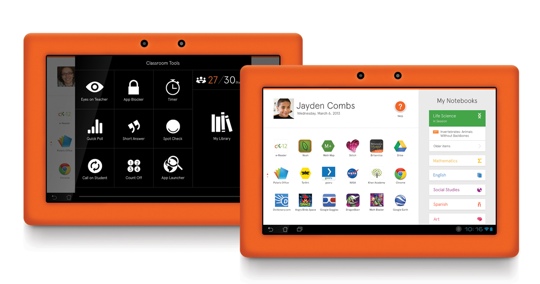Amplify is one of the most scrutinized companies in education technology—only partly because its parent company is News Corporation. When News Corp. acquired Wireless Generation for $390 million in 2010—a deal that became the cornerstone for Amplify—it boldly promised to usher in a digital revolution in school. It came equipped with a powerful financial war chest—$1 billion, by some estimates—to support that mission.
But turning that vision into real technology has proven to be complex, complicated by politics, missteps and an ambitious plan to deliver a wide range of different products and services. Now Amplify faces the single biggest challenge in its life: Can it weave together a collection of independent efforts—and win customers along the way?
Concerns about Amplify ring loud and clear: Of News Corp.’s five divisions, only Amplify has posted annual losses. During its past two fiscal years (which end June 30), it posted losses of $193 million and $141 million, respectively. Losses slowed during the last three months of 2014 but Amplify’s quarterly revenue stayed flat at $22 million. News Corp.’s top boss, Rupert Murdoch commented in 2012 he would be “thrilled” if Amplify made up 10 percent of the company’s overall business revenues over the following five years. In fiscal 2014, Amplify accounted for $88 million--or roughly one percent.
A shakeup is underway. This past January, Amplify CEO Joel Klein sent an internal memo to his staff: “It’s time to move past thinking about divisions and instead focus on our collective strengths,” he wrote. “That’s why I’ve decided to begin the process of fully integrating Amplify.”
How Many Amplifys?
The watchword within the company is “One Amplify,” Klein’s code name for a reorganization effort aimed at uniting a company that once listed 12 “C-level” executives and three presidents across five divisions. Today, seven chief officers remain—and no presidents.
“Over the past year, I’ve met with a majority of you in person to talk about where we are as a company and where we need to go,” Klein wrote in his January note. “What rang out loud and clear was your strong desire to see us all work more closely together.”
Amplify has had plenty of parts, including tablets, assessments, curricula, professional development, games, and consulting services. The one product often associated with Amplify is the orange tablet, unveiled in March 2013 with fanfare—only to be chastised a few months later after a messy rollout involving cracked screens and a melted charger. It was a big stumble out of the gate, and despite the company’s punctual efforts to patch up the issues, many questioned Amplify’s ability to deliver.

The tablets overshadowed a much more established business inherited from Wireless Generation: assessments. Amplify currently offers literacy and math assessments that have won statewide contracts in North Carolina and Colorado, and scored a $12.5 million deal with Smarter Balanced to create a library of instructional resources aligned to the Common Core standards. Amplify also has a division responsible for a potpourri of print and digital curricula, the latter of which is used by approximately 30,000 students.
The tablet, assessment and curriculum products made up Amplify’s Access, Insight and Learning divisions, respectively. Nestled within them have been teams in charge of other digital products like “Professional Learning Maps,” which helps teachers understand data, and a suite of 30 educational games, developed by 13 independent studios contracted by Amplify.
The explosion of Amplify’s product lines was intentional. The executive team purposefully set up the three divisions to operate independently. Building and selling tablets, assessments, curriculum, games and professional development each required their own unique set of product development and sales expertise, went one version of the logic. The decision was reflected on the company’s leadership page, where each division has a distinct executive team.
Creating autonomous teams seemed like a sound idea for a company with a staff of more than 1,000. But former employees say it was sometimes difficult to know who was in charge. Further complicating matters was the fact that different product teams and divisions used different development tools—some used Stash, others used Github, for instance—which made collaboration across groups very challenging.
There were also technical legacy issues inherited from Wireless Generation: Attempting to share data and code across projects built on different architectures, and at different times, proved problematic.
From Many to One
Klein wondered, in a February memo sent to the company, whether Amplify’s curriculum and assessment tools could be integrated. “We have several groundbreaking products in early literacy instruction, assessment and intervention….How much more transformative could it be if they all worked together?”
In that note, he spelled out the goal for One Amplify: “Amplify will be configured as one company, with a united mission and vision: to reimagine the way teachers teach and students learn.” Critical to its success will be ensuring that “our products will be built with common technologies. We will embrace open architectures and will integrate with diverse technologies relevant to our customers.” In addition, “key resources and support services common to our business needs will be shared across the company.”
One of the first moves was to streamline technical leadership. Klein named Josh Hartmann, previously Chief Technology Officer at Amplify Access, to that role for the entire company and pledged Hartmann would “collaborate with leadership across the company as we work to build an integrated product development team.”
Klein also announced the formation of a cross-division working group to explore how to integrate the company’s curricula and assessments. Two other groups mentioned in the note will explore how to streamline sales efforts for professional development products, and build prototypes to make its digital content more readily available on “several emergent digital platforms.”
Conspicuously absent in Klein’s two memos is any mention of the orange tablet, which the company has put into the hands of 30,000 students. Coincidentally, Stephen Smyth, who joined Amplify in October 2012 and served as the Access division’s president and chief executive, is no longer listed on the company’s leadership page. (His LinkedIn profile is ambiguous about whether he is still at Amplify. Neither he nor the company responded to questions about his status.)
Up, Up or Away?
Klein has often likened Amplify to a startup. And, despite commanding financial resources that any company would envy, he may be right: like many young edtech entrepreneurs, Amplify has been trying to find a sustainable product-market fit. Far from resembling a coherent package, the company’s tools, and the teams building them, look like siloed efforts.
Amplify’s games have enjoyed strong reviews, a sign that the the company has the talent and resources to create engaging products. But the path toward One Amplify’s vision—“to reimagine the way teachers teach and students learn”—remains hazy. Product integration is one step. Will the company continue to compete in the tablet and curriculum markets against the likes of Apple, Google and Pearson? Will it rely on digital assessments to carry the company? Will it try to sell off pieces that don’t fit?
"We’ve helped more than 200,000 educators and 3 million students in all 50 states begin their digital transition,” said an Amplify spokesperson, who added the company remains “...committed to a process of continual improvement…”
Klein said in his February memo that the company is “in the early innings of our integration effort,” but for some the reorganization can’t come soon enough. One employee, writing on Amplify’s Glassdoor page, advised management to “complete the One Amplify initiative quickly and quit dithering. Streamline the C level to reduce redundancy.”


